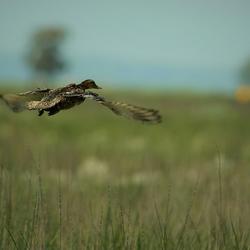Wildlife Disease Surveillance
Wildlife Disease Surveillance
Filter Total Items: 52
Genomics to Aid Conservation and restoration of the Yellow Lampmussel (Lampsilis cariosa) and Tidewater Mucket (Atlanticoncha ochracea)
Due to the rapid decline in abundance of Yellow Lampmussel ( Lampsilis cariosa) and Tidewater Mucket ( Atlanticoncha ochracea), USGS and partners at the U.S. Fish and Wildlife Service (USFWS) and Central Michigan University (CMU) are conducting an assessment of genetic diversity and population structure to inform appropriate recommendations for conservation and management of each species. These...
Deriving Spatial and Temporal Waterfowl Inputs for Disease Risk Modeling
USGS is creating spatially and temporally explicit inputs to improve avian influenza transmission risk modeling. This project places special emphasis on wild bird distribution and abundance models as well as avian influenza prevalence models.
USGS Chronic Wasting Disease Research at the National Elk Refuge
Over the past 20 years, chronic wasting disease (CWD) in Wyoming has been spreading slowly outward from the southeastern corner of the state into the Greater Yellowstone Area and Wyoming's elk feed grounds. CWD detections have been getting closer to the National Elk Refuge, which provides supplemental feeding to approximately 8,000 elk and 500 bison each winter. NOROCK scientists have been...
Expanding Distribution of Chronic Wasting Disease
Chronic wasting disease (CWD) has been detected in 36 US states and five Canadian provinces in free-ranging cervids and/or commercial captive cervid facilities. CWD has been detected in free-ranging cervids in 36 states and four provinces and in captive cervid facilities in 22 states and three provinces.
The influence of natural mineral licks on wildlife disease dynamics
Some locations on the landscape can aggregate animals of multiple species and could become hotspots of disease transmission. One example of this are areas of localized concentrations of minerals that animals like deer, elk, bighorn sheep, and mountain goats use and diseases like chronic wasting disease or respiratory diseases could spread among or within species who use natural mineral licks...
Understanding Avian Influenza Exposure and Antibodies in Understudied Species
Recent outbreaks of highly pathogenic avian influenza have impacted a dramatically wider range of bird hosts than ever before. USGS researchers are working to identify which bird species have been exposed, which have developed immune responses, and how these species may influence viral ecology to inform risk management activities.
Using Telemetry to Understand Overlap in Habitat Use Between Waterfowl and Agricultural Birds in North America
USGS researchers are using telemetry to improve our understanding of how wild birds move throughout their environments and the potential implications for disease transmission within and to domestic poultry.
Avian Influenza Spread, Prevalence and Persistence
USGS researchers seek to understand the factors influencing the spread and persistence of avian influenza viruses on the landscape. This research also addresses how novel strains of highly pathogenic avian influenza are impacting a larger number and diversity of host species, including waterfowl, shorebirds, raptors and other birds.
High Priority Species for Avian Influenza in Alaska
In early 2006, an Alaska Interagency Avian Influenza Working Group was formed to develop a ranking matrix for selecting priority species to be sampled within Alaska. Most wild bird species with populations that utilize areas of both Alaska and Asia were identified and considered in the ranking exercise. Based on scoring criteria, 28 target species were chosen for sampling. Alaska is a...
Bird Migration and Influenza
The movement and transmission of avian influenza viruses in wild birds may differ by the migratory nature of each host species.
Avian Influenza Viral Pathogenicity
USGS is collaborating with numerous partner institutions to explore the susceptibility to and pathogenesis of relevant avian influenza strains in waterfowl species with special emphasis on sea ducks and diving ducks.
Avian Influenza Surveillance
The USGS National Wildlife Health Center (NWHC) conducts surveillance in wild birds to facilitate early detection and situational awareness for high consequence pathogens, including highly pathogenic avian influenza (HPAI) viruses.













